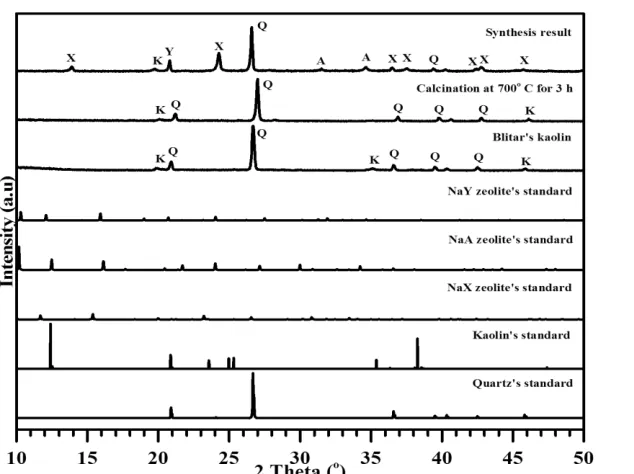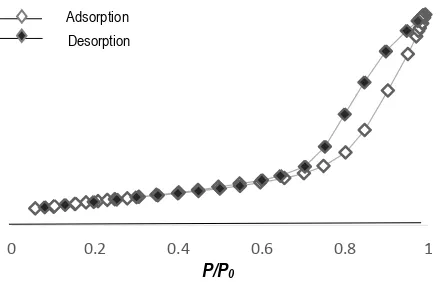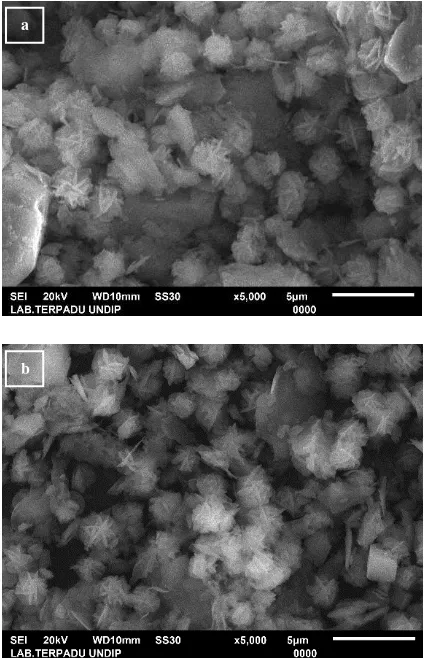5 : 3 (2017) 100-105ǀ ALCHEMY: Journal of Chemistry ǀ EISSN 2460-6871
Journal of Chemistry
Research Article
Synthesis and Characterization of Mesoporous NaX Zeolite from Kaolin
Loading of Soursop Leaves Extract (
Annona muricata
Linn.)
Ilmin Nasifah*, Susi Nurul Khalifah, Elok Kamilah Hayati
Chemistry Departement, Science and Technology Faculty, Universitas Islam Negeri Maulana Malik Ibrahim Malang, Indonesia
ARTICLE INFO ABSTRACT
Article history
Received 10 March 2017 Accepted 30 March 2017 Available online 9 January 2018
Mesoporous NaX zeolite has been synthesized from calcined kaolin with the addition of 5M NaOH and CTABr surfactant as mesoporous template by hydrothermal method. The result of synthesis was used as anticancer loading agent of ethanol extract soursop leaves. Characteristics of zeolite were studied by XRD, IR spestroscopy, Nitrogen Adsorption and SEM analysis. The mesoporous NaX zeolite has been formed with mixing of A, Y, kaolinite and quartz phases. The surface of zeolite particles has changed from amorphous to regular and uniform particles. The pores of NaX zeolite belongs to mesoporous type with size 6.13 nm. Loading process of soursop leaves extract on zeolite decreased intensity and crystallinity of zeolite peaks. The new absorption in soursop leaves extract loaded on zeolite spectra was detected at 2928.174 cm-1. The surface of zeolite seen to be compact
and irregular.
Keywords: soursop leaves extract, kaolin, mesoporous, NaX Zeolite
* Corresponding author: Email: [email protected]
1. Introduction
Cancer is one of diseases that cause high mortality in the worldwide. The disease caused mortality approximately 347,792 in Indonesia (Kementerian Kesehatan RI, 2017). To overcome the case, soursop leaves can be alternative to cure cancer because of the cytotoxic activity. Development and enhancement of cytotoxic activity of soursop leaves is continually developed to improve the efficiency. Pavelic & Hadzija (2003) states that the level of drug efficiency increased when the release process of the drug is more controlled. Inorganic material nowsday has been explored for biomedical applications in combining drugs into inorganic systems (Amorim et al., 2012). In this case, zeolite as an inorganic material can be applied as drug carrier system (Drug Delivery Sytem/DDS).
Zeolite with pore structure can be used as carrier system. The drug molecules present in the pores and on the surface that able to diffuse out of the system slowly, then rate of releasing drug can be controlled. Cavallaro et al., (2004) reported syntetic zeolite has more uniform pore that can be increased the biological essence and mechanical properties in the DDS. Zeolite with various types is very potential in this case. X zeolite synthetic has been quite effective with no negative effect when encapsulated on ketopofren drug based on research of Rimoli et al. (2007).
101
& Taylor (2012) formed zeolite NaX from kaolin Ahoko Nigerian with high crystallinity.
Neves et al. (2013) stated salicylic acid drug encapsulation was 56.7% more efficient in mesoporous than in micropore zeolites. The pore size of zeolite structure effected supporting drug optimization. Therefore, zeolite pores were need to be changed into mesoporous size (2-50 nm). The pore size conversion can be accomplished by the addition of surfactant template cetiltrimethyl ammonium bromide (CTABr) (Qoniah et al., 2015). Hartanto, Purbaningtias, Fansuri, & Praetyoko (2011) produced ZSM-5 with pore size of 3.8 nm with the addition of similar surfactant. Y zeolite with pore size of 25-30 nm has been obtained with the addition of CTABr and tetramethylammonium hydroxide (TMAOH) surfactants (Holmberg, Wang, & Yan, 2004).
The aim of this research was to know the characteristics of mesoporous NaX zeolite from Blitar’s kaolin (Indonesia). Characterization of zeolite after loaded with soursop leaves extract was studied also by X-ray diffraction, infrared, nitrogen adsorption and Scanning Electronic Microscopy (SEM).
2. Materials and methods
2.1. Materials
Kaolin sample was obtained from Blitar, Indonesia. Ethanol extract of soursop leaves was impregnated to zeolite product. Other reagents were NaOH (Sigma-Aldrich), CTABr 65% (Merck), HCl (Merck 37%), Al2O3 99% (Merck), ethanol
99.8% (Sigma-Aldrich).
2.2. Sample preparation
The sample washed using destilated water then crushed and sieved with 200 mesh. Sample was leached with HCl 1 M and carried out by continous stirring for 1 h. The product was neutralized up to pH 7 and filtered, then it heated up at 100°C, 6 h. The product continually calcined
at 630°C for 10 h, 700°C for 3 h, and 800°C for 24
h to form metakaolin phases.
2.3. Synthesis of mesoporous NaX zeolite
Synthesis of zeolite was conducted by hydrotermal method. The starting materials such as kaolin, NaOH and Al2O3 were mixed to give final was incubated at room temperature, 4 h. The result was transferred into a hydrothermal reactor and heated up at 100°C for 24 h (Kovo & Taylor, 2012).
Solid products were separated and precipitated through neutralization using destilated water. The final product was dried at 60°C, 24 h. The dried product was calcined at 550°C (6 h) to decompose
surfactant.
2.4. Soursop leaves extract loaded into mesoporous NaX zeolite
The loading process was performed using dry impregnation method. The NaX meoporous zeolite dried for 24 h, 40°C. Further, zeolite was mixed with soursop leaves extract using ratio of 10: 1. The stirring was continued for 48 h. Then, the mixture fed into the oven (80°C, 6 h) to evaporate the excess solvent of soursop leaves extract.
2.5. Characterization of kaolin and synthesis product
The sample of kaolin before and after leaching were characterized by XRF (X-Ray Fluorescene PANalyctical, Type: Minipal 4). Kaolin and synthesis product sample were characterized using X-Ray Diffraction Philip X'Pert MPD technique using CuKα wavelength λ = 1.541 Å with angle range 2θ = 5-50˚. The infrared spectroscopy range 400-4000 cm-1 of vibration bands characteristic
were monitored by FTIR Shimadzu 8400. The morphology images were recorded using SEM (Zeiss EVO type MA 10) and isotherm sorption gas nitrogen was observed using the NovaWIn Quantachrome instrument (Nova-11.03). The specific surface area was determined by the BET (Branauer-Emmett-Teller) equation and the pore size distribution was analyzed from the desorption path.
3. Result and discussion
3.1. Synthesis of mesoporous NaX zeolite
102
Tabel 1
Comparation of percentage element of Blitar’s kaolin
Component Weight (%)
Before leaching After leaching
Al 12.0 8.80 figure showed NaX zeolite was successfully formed. It was indicated by the appearance of new peaks at 2θ = 13.9, 24.3, 36.4, 37.4, 42.4, 42.7, 45.7 and the 2θ value shift with a trend approaching the NaX International Zeolite Association (IZA) standard. However, NaA and NaY zeolites also form as well as the peaks of kaolin and quartz that changed completely from the raw material. Calcination at 700˚C (3 h) to form metakaolin gave the best results with low peak quartz intensity than other temperature treatments.
The changing of kaolin into metakaolin based on IR spectroscopy (Fig. 2). The peak of 3623 cm-1
is corresponded to the absorption of OH (Al-O-H) strain on the inner kaolin layer structure. The absorption band does not appear on the spectra (b). It was the dehydroxylation of the OH group on the kaolin structure to form metakaolin. Furthermore, the absorption peak of 904.6, 795.7 and 462.9 cm-1 decreased the intensity indicated
the NaX zeolite has already formed.
4000 3500 3000 2500 2000 1500 1000 500
%
Fig. 1. The XRD pattern of kaolin, metakaolin and synthesis product. Q = Quartz, K = kaolin, A = zeolite NaA, Z = zeolite NaX
Wavelength number (cm-1)
103
The transformation of kaolin morphology and synthesis product was showed in Fig. 3. The regular repeated layered structure of kaolin has changed to amorphous as character of metakaolin.The forming of NaX zeolite was characterized by the transformation of amorphous into particles in a regular and uniform shape.
The synthesized product is mesoporous material clarified by surface area using BET method and pore size distribution using BJH method. The isotherm graph in Fig. 4 illustrated the formation of loop hysteresis at relative pressure of 0.6 to 0.9. The graph is type IV showed the identical character of mesoporous material. The graph also classified into H-4 and has a slit pore shape characteristics that can be occured between particles and or at each particle (Naumov, 2009).
Fig. 4. Isotherm graph of mesoporous NaX zeolite
Table 2 informed comparison of pore distribution and surface area of mesoporous NaX
zeolite with Blitar’s kaolin. The product changed to large size pore distribution, from 1.73 to 6.13 nm, and large surface area, from 16.16 to 59.97 m2/g.
The data was supported the mesoporous zeolite was successfully formed.
Table 2.
Surface area and size pore distribution of kaolin and mesoporous NaX zeolite
Sample Surface are (m2/g) BET
Pore size distribution (nm) BJH
Kaolin 16.16 1.72
NaX zeolite 59.97 6.13
3.3. Soursop leaves extract loaded into mesoporous NaX zeolite
The structure of mesoporous NaX zeolite showed no significant changing either before or after loaded with soursop leaves extract. No new
peaks or 2θ value shift were detected on XRD pattern (Fig. 5). The intensity and crystallinity of mesoporous NaX zeolite peaks were decreased. It means that soursop leaves extract did not changed the zeolite structure.
5 10 15 20 25 30 35 40 45 50
Intensitas
(a.u)
2 Theta (o)
Before Impregnated After Impregnated
0 0.2 0.4 0.6 0.8 1
Fig. 3. SEM images (a) Kaolin, (b) Calcined kaolin (metakaolin), and (c) Synthesis product (NaX zeolite). Magnification is 5000x.
a b c
Adsorption Desorption
P/P0
104
There is a new absorption peak detected using IR spectroscopy at 2928.174 cm-1 in Fig. 6).
An asymmetric strain vibration of a C-H bond interpreted as one of the functional groups possessed by acetogenin compounds in soursop leaves extract.
4000 3500 3000 2500 2000 1500 1000 500
%
Tr
an
smi
ttan
(a.
u
)
Bilangan gelambang (cm-1 )
a b c
2928,174
SEM images of the synthesis zeolite product before and after loaded were presented in Fig. 7. The surface of the mesoporous NaX zeolite appeared denser and more disordered than it was before loaded. The result indicated that extract of soursop leaves covered particles on the zeolite surface.
4. Conclusion
Mesoporous NaX zeolite has been formed with mixed with A, Y and kaolin and quartz phases that have not been completely changed. The morphology of zeolite was regular and uniform shape. NaX synthesized zeolite pores are classified into mesopores with pore size of 6.13 nm and has surface area of 59.97 m2/g. Mesoporous NaX
zeolite peaks were decreased, hence, the crystallinity after being loaded. There was a new absorption peak that belongs to acetogenin compound from soursop leaves extract and the morphology of zeolite changing to denser and more disordered than it was before loaded.
Fig. 7. SEM images of zeolite (a) before and (b) after loading.
References
Akolekar, D., Chaffee, A., & Howe, R. F. (1997). The transformation of kaolin to low-silica X zeolite. Elsevier, 19(5-6), 359-365.
Amorim, R., Vilaca, N., Martinho, O., Reis, R.M., Sardo, M., Rocha, J., … Neves, I.C. (2012). Zeolite structure loading with an anticancer compound as drug delivery systems. The
Journal of Physical Chemistry, 116(48),
25642-25650.
Atta, A.Y., Ajayi, O.A., & Adefila, S.S. (2007). Synthesis of faujasite zeolites from Kankara kaolin clay. Journal of Applied Science
Research, 3(10), 1017–1021.
Cavallaro, G., Pierro, P., Palumbo, FS., Testa, F., Pasqua, L., & Aiello, R. (2004). Drug delivery devices based on mesoporous silicate. Drug Deliver, 11(1), 41-46.
Hartanto, D., Purbaningtias, T.E., Fansuri, H., & Prasetyoko, D. (2011). Karakterisasi struktur pori dan morfologi ZSM-2 mesopori yang disintesis dengan variasi waktu aging. Jurnal Ilmu Dasar,12(1), 80-90.
b
Fig. 6. IR spectra: (a) Mesoporous NaX zeolite, (b) Soursop leaves extract, and (c) Zeolite-loading extract.
Wavelength number (cm-1)
105
Holmberg, B.A., Wang H., & Yan, Y. (2004). High silica zeolite Y nanocrystal by dealumination and direct synthesis. Microporous and Mesoporous Materials, 74(1-3), 189-198. Kementerian Kesehatan RI. (2017). Kementerian
Kesehatan ajak Masyarakat Cegah dan kendalikan kanker. Diakses 10 Februari
2017, dari
http://www.depkes.go.id/article/print/1702020
0002/kementerian-kesehatan-ajak- masyarakat-cegah-dan-kendalikan-kanker.html
Kovo, A., & Taylor, P. (2014). Effect of temperature on the synthesis of zeolite X from Ahoko Nigerian kaolin using novel metakaolinization
Technique. Chemical Engineering
Communications, 199(6), 786-797.
Neves, I.C., Vilaca, N., Rocha, J., Fonseca, A., Baltazar, F., Pareira, R., … Machado, A.F. (2015). Micro and mesoporous structures as drug delivery carriers for salicylic acid. Journal of Physical Chemistry, 119(7), 3589-3595.
Naumov, S. (2009). Hysterisis phenomena in mesoporous materials. Dissertation. Von
der Fakultät für Physik und
Geowissenschaften der Universität Leipzig. Genehmigte.
Pavelic, K. & Hadz’ija, M. (2003). Medical
applications of zeolites. In S.M. Auerbach,
K.A. Carrado, P.K. Dutta, Handbook zeolite science and technology. New York, Marcel Dekker, Inc.
Qoniah, I., Prasetyoko, D., Bahruji, H., Triwahyono, S., Jalil, A.A., Suprapto, Hartati & Purbaningtias, E.T. (2015). Direct synthesis of mesoporous aluminosilicates from Indonesian kaolin clay without calcination.
Applied Clay Science, 118, 290–294.


